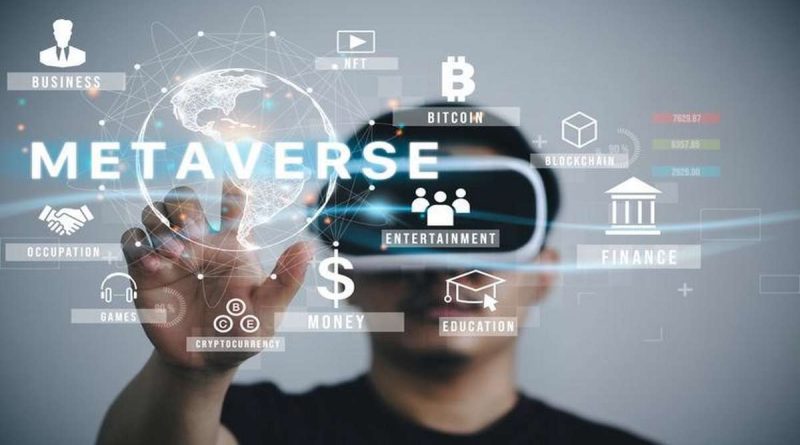Metaverse as New Marketing Channel – The Corporate Metaverse
During the pandemic, one of the most significant new marketing platforms emerged: metaverse marketing. For those who are unfamiliar with the term, a metaverse is an immersive, digital environment populated by virtual
Technology is rapidly evolving and changing. We are witnessing previously unimaginable innovations. For many people, one of these innovations is the metaverse—a unique, immersive virtual environment that is quickly taking over the internet. It may have first appeared in science fiction films such as Ready Player One or The Matrix, but it is now more than fiction.
Virtual reality and augmented reality are becoming more famous, the metaverse is permeating the internet. It is expected that approximately 85 million users will engage in at least one AR or VR experience per month. While the Metaverse isn’t exactly what science fiction has portrayed it to be, it is still producing unimaginable value as a new computing platform.
The metaverse of today is a shared virtual space where users are represented by virtual avatars. These virtual worlds continue to evolve and grow as a result of user decisions and interactions within the space. To that end, it is similar to the real world in that it has no “end.” It’s just a universe that keeps growing as more people join in.
It’s not just a simple virtual theme park with a centralized design, nor is it just a simple game designed solely for the enjoyment of children. It’s also not a straightforward app that you can get from the app store and “play” whenever you want. Metaverses are virtual universes that bridge the gap between the real and virtual worlds.
Key features of metaverse:
Always on the move – Metaverses do not pause or end when you leave them. They just keep going indefinitely.
Real-time exists – There is a timeline in the metaverse that corresponds to real-world time.
Individual players have agency – They can participate in multiple activities at the same time. One could simply stand in the corner and observe how others interact.
Self-contained and fully functional universe – The metaverse is a fully functional universe in which users can create, own, sell, and invest. Users’ efforts in the metaverse can be recognized and rewarded.
A variety of platforms are used – Different platforms can collaborate in the metaverse. For example, in video games, you should be able to transfer items from one game to another.
Content created by users – Metaverses is more than just virtual hangouts for users. Users can create content that other users will appreciate.
The Metaverse Marketing
Digital marketers must keep up with the latest technological developments. Understanding the metaverse in business and its full potential is a necessary step. Marketers must recognize that the metaverse is not a passing fad; rather, it appears to be here to stay and on its way to becoming the next big thing.
How Can Marketers Adjust as the Metaverse Grows?
To begin, marketers must remember the importance of millennials and Gen Zers as target markets. These generations are also avid users of some types of metaverses, such as Roblox games and VR technologies. With that in mind, let’s look at how to market in the metaverse.
Parallel Marketing in the Metaverse Within Real-World Marketing
Create marketing experiences that are related to or parallel what your brand already does in real life. For example, in June, AB InBev’s Stella Artois collaborated with Zed Run to create a Tamagotchi-meets-Kentucky Derby experience. This was done because AB InBev’s Stella Artois is a big supporter of sporting events, particularly horse races. As a result, developing an online platform where non-fungible token (NFT) horses can be traded, raced, and bred appears to be a natural next step for them.
Immersive Experience Is Essential
In the metaverse, you can provide virtual advertising. Bidstack, a video game ad tech company, for example, transitioned from real-world outdoor advertising to placing ads on virtual billboards.
You can, however, go beyond virtual billboards. Because metaverses are experiential and immersive in nature, it’s best to capitalize on this by providing the exact immersive experience with your advertisements and marketing initiatives. Instead of simply placing ads, provide branded installations and events with which users can interact.
We’ve seen early adopters provide immersive experiences to their users, such as a Lil Nas X concert in Roblox, Gucci Garden experience visits, and Warner Bros.’ promotion of In the Heights with a virtual rendition of the Washington Heights neighborhood. Collaborations with the Roblox metaverse and other metaverses have recently revealed new revenue streams for brands.
Collectibles Should Be Made Available
People enjoy collecting things, and the metaverse gives them yet another place to do so. You can replicate the experience in the metaverse by making assets or limited-edition items available only in the metaverse.
The Collector’s Room, for example, is available in Roblox’s Gucci Garden experience. It enables people to amass a limited number of Gucci items in the metaverse. Gucci earned 286,000,000 Robux from the game’s initial sales of collectible items.
Participate in existing communities
People are generally opposed to advertising. As brands attempt to enter the metaverse, it is critical that they do not annoy those who are already present. More than that, you’ll need these users’ approval because you’ll be marketing to them. Remember that you cannot simply enter a new platform without considering the new format.
Brands gain traction in Roblox, for example, when they collaborate with members of the Roblox developer community to create items and experiences. Similarly, when O2 hosted a Fortnite concert, they collaborated with creators who were already experts on the Fortnite platform.
Consider this to be an influencer campaign. Because user-generated content is important, members of your community should be involved in the execution of your campaigns.
Experiment frequently
Marketers are living in an exciting time. While there are guiding principles that can help marketers decide what kind of strategies and tactics to use, the metaverse is still a relatively new platform with plenty of room for experimentation. Best practices have yet to be established properly, and paradigms have yet to be fully and comprehensively developed. This provides ample opportunity for marketers to be creative and experimental in their approaches.
How Will the Metaverse Affect Growth Marketing?
Growth marketing is a method of attracting, engaging, and retaining customers by using customer data, experimentation, and cross-channel marketing to exponentially scale your business. It is a marketing technique that works in tandem with traditional marketing. Importantly, growth marketing focuses on all funnel stages rather than just generating leads and concentrating on the top of the funnel:
A growth marketing strategy consists of a few basic components, which are as follows:
A data-driven strategy for marketing and growth.
Ongoing experimentation and testing.
Analyzing and optimizing marketing campaigns and strategies in real-time across all marketing channels.
Adaptability
How Will the Metaverse and Growth Marketing Coexist?
The metaverse has arrived and is rapidly expanding. As a result, it is an ideal location for brands and marketers to connect with their target audience. 3D worlds will soon rule, just as social networking platforms are used by billions of people worldwide and social media marketing is now a must-have for brands of all sizes.
But how will the metaverse affect marketing, and how (if at all) can it be used for growth marketing? The following are some of the expected future effects of the metaverse on growth marketing:
1. More Data for Growth Marketing Thanks to the Metaverse
Because it is entirely data-driven, the metaverse is a goldmine for growth marketers. The virtual world is built around data, which makes a lot of room for growth marketing. The gadgets used for interaction in the metaverse (e.g., VR glasses) generate heaps of data. Data from the metaverse can be used to promote your brand to your target audience both on and off the metaverse. If your buyer persona interacts with the metaverse, for example, you can track that behavior and use it to connect with the same persona on traditional marketing channels. According to this viewpoint, the metaverse will have a significant impact on growth marketing. Even if you don’t plan to use the metaverse as a marketing platform, you can still use data from the metaverse to fuel your growth marketing strategy.
2. The Metaverse Is Very Active
Engagement and retention are two of the most important aspects of growth marketing, and they can be found in the metaverse. The engagement rate for the metaverse is extremely high. According to research, 65 percent of Gen Z has spent money specifically on virtual gadgets that are only used within a game. This demonstrates the metaverse’s level of engagement. The metaverse can prove to be an ideal platform for growth marketing. If you want to engage and retain your ideal customers, consider creating a virtual world for them where they get hooked. This is one example of how brands can use the metaverse to elevate engagement in any industry.
3. Cross-Channel Marketing Has Become Easier
Cross-channel capabilities are essential in both the metaverse and growth marketing. According to Mathew Ball, one of the key characteristics of the metaverse is its mix of online and physical platforms, private and public networks and platforms, and open and closed networks and platforms. Decentraland, The Sandbox, and Somnium Space are among the most popular metaverse platforms. As a result, you can market to and reach your target audience across multiple platforms, including a 3D platform and a VR platform. This makes the metaverse a game changer because it will provide an additional channel for connecting with your audience. As a growth marketer, you must ensure that your audience has the same experience in the virtual world as they do in the real world. This proves to be both difficult and interesting at the same time.
4. Experimentation Space
The metaverse is still in its early stages. The rules have not yet been established, and no one knows where it will lead. This means that virtual worlds are constantly experimenting, which is a key feature of growth marketing. Experimentation and testing aid in the improvement and optimization of marketing variables. The more testing you do, the better, because you’ll be able to discover what works and what doesn’t in the metaverse when it comes to marketing and growth.
Not to mention the advantage of being the first to market. While other brands are still on the fence and haven’t jumped on the metaverse bandwagon, if you start experimenting and optimizing your campaigns, you’ll be far ahead of your competitors.
5. A New Type of Content
As we move towards the metaverse, new types of content such as virtual and augmented realities are emerging. According to Google, augmented reality is the process of superimposing digital content and information onto the physical world. In addition, Google generates 3D experiences from existing content, such as local listings and images. This new content has ushered in an entirely new era of content marketing and inbound marketing. Consider visual search, image processing, and other applications. The metaverse’s 3D content has created a new growth marketing opportunity. Because growth marketing and inbound marketing rely heavily on content and SEO, this will have a significant impact.
What Does the Metaverse Mean for Brands and Marketing?
While the metaverse is not a new concept, it gained popularity after Mark Zuckerberg used the term repeatedly in a late October earnings call. VR, AR, blockchain, NFTs, and other Web3 technological advancements enable immersive social interactions online and bring physical world elements online, allowing us to “move ourselves and goods seamlessly between our digital and physical worlds.”
The industry is still debating how the metaverse will and has influenced traditional business functions such as advertising and marketing. However, we have yet to investigate in depth what this convergence of the real and digital worlds will mean for branding.
The Function of a Brand in the Digital World
A brand serves two important functions for the consumer. The first is as a trust value that ensures a company’s credibility, quality, and beliefs. Nike, for example, has a strong, dependable brand. If my Nikes break, I know the company will stand behind them. The second is signaling or self-expression. A brand expresses to others how they want to be perceived. People were more commonly the “brand” centuries ago. The brand, not the company, was John, the local horseshoe maker. Today’s world is more expansive, and brands have taken on a more important role as trade has expanded beyond borders.
However, in the metaverse, your digital sneakers are unlikely to be defective, emphasizing the importance of a brand’s self-expression above all else. While there are still trust elements to consider, such as longevity and value continuity, branding in the metaverse is dependent on marketers’ ability to bring their brands to life in a specific way in a specific environment. When someone digitally showcases a brand, the power of signaling precisely what they mean and who they are growing exponentially. Branding in the metaverse necessitates a fundamental shift in approach, similar to how marketers transitioned from catalogs to e-commerce and then to anywhere-commerce.
Developing Metaverse Branding Strategies
With the metaverse emphasizing brand image to a new level, brands must more clearly define their personality, core values, and stance on social issues (if they choose to do so) than ever before. Being everything to everyone is a death sentence for a brand because it makes self-signaling impossible in a world where self-signaling is the primary reason for brand ownership. Surprisingly, IRL (in real life) quality remains important. If a car is known in the real world to be unreliable, consumers will extend this concept to the digital world and avoid that product. This is because all brand interactions, whether physical or digital, create a single brand personality and image. So, how can brands shift their strategies to build a strong brand image in the metaverse that resonates with and provides value to consumers?
Understand Your Brand and Audience
Before diving into the metaverse with your brand image, marketers should ask themselves a few key questions. What does my brand represent? Who are my clients? What do they hold dear? Many marketers will scoff at these questions, but they are essential for any good marketer! However, how a marketer defines a brand’s personality and how a consumer perceives it is frequently at odds. Understanding this completely provides a clear understanding of both the brand and its customers, which is critical in shaping the brand’s image and messaging in the metaverse. It also provides the guidance required to create synergy between a brand and its customers in order to accurately signal who they are.
Adopt an Authentic Approach
To avoid being perceived as gimmicky, marketers must nail their brand’s metaverse voice and persona. How? By being genuine. This means that the digital brand has a voice that is appropriate for the platform and represents “how the brand would behave” in that environment. This desire for authenticity extends to the experiences marketers create in the metaverse. Whether a brand is incorporated into games, media and content, or digital items — NFTs, anyone? — it must also naturally integrate with the world around it.
It’s Not About Economics, It’s About Behavioral Economics
Consumers will purchase or compete for rare items to elevate their perceived status, as demonstrated by games like Fortnite. This is where the scarcity principle comes into play. Anchoring and loss aversion, for example, work just as well in the metaverse as they do in the physical world. Because signaling will play such a large role in marketers’ branding strategies in the future, brands must have a thorough understanding of how people think, behave, and respond to cues and signals. With these considerations in mind, marketers can develop a branding strategy that fosters a stronger connection with customers and meets their desire for value, community, and metaverse experiences.
The most important aspect that marketers must embrace is experimentation. Because the metaverse isn’t fully formed yet, marketers have plenty of time to thoroughly test their branding strategy, failing spectacularly and adapting to perfect their technique.
What Impact Will the Metaverse Have on Digital Marketing?
With metaverse marketing, as with any new medium, simple ideas can have a big impact. Some brands have already established a presence. Hyundai, for example, collaborated with Roblox to create the Hyundai Mobility Adventure in order to familiarize young consumers with their products. Warner Bros. also held a virtual party to promote a 2021 film.
Although there are numerous opportunities in metaverse marketing, brands must be cautious and strategic in their approach. We are still in the early stages of consumer engagement with the metaverse, and the space is rapidly evolving. In order to maximize value, brands must consider the following:
Define your metaverse marketing objectives: Recognize why you want to be in the metaverse. Is it to reach out to new people? Improve the image of your company? Encourage customer loyalty?
Determine which platforms are appropriate for your brand: Not every metaverse game or platform, like social media platforms, will be appropriate for your brand.
Create experiences that are appealing to the intended audience: Make certain that you are providing new and exciting experiences to your target demographic.
Experiment with different types of advertising: Experiment with different ways to generate revenue through advertising in the metaverse.
Rethink your success metrics: To account for the metaverse’s unique behaviors, marketers must define new engagement metrics.
How Will Social Media and Content Marketing Change?
What will become of social media marketing in the Metaverse?
Future social media systems may resemble Fortnite and Roblox. It will enable users to create 3D augmented reality avatars for use in browsing websites and making purchases. Marketers have a plethora of options at their disposal. And it is certain that VR will have an impact on the Metaverse customer journey from beginning to end. When it comes to content marketing, only about 3% of the content on the internet today can be classified as interactive. The majority of internet content is passive, including videos, images, and other media.
Videos and Gifs are already popular, and the Metaverse has the potential to change this by facilitating the creation and sharing of interactive graphics that respond to user actions. Exploration and discovery are encouraged by interactive media. Brands can benefit from this by providing users with a fun and engaging ways to learn more about their products, services, and missions. Brand experiences that are similar to real-world situations or reflect what a brand does in real life will assist brands in building long-term relationships with their customers and leads.
The Metaverse Provides Limitless Marketing Opportunities
In the short term, the types of digital advertising and marketing you can conduct in the metaverse may be limited. A cookie manufacturer, for example, may rely on the aroma of freshly baked chocolate chip cookies to sell their product. Unfortunately, smelling digital cookies is not an option. As a result, some businesses may need to be more creative in how they market their products.
Within the metaverse, however, there is far more flexibility than limitations. A natural history museum, for example, could promote a new dinosaur exhibit by enticing young users to spend an afternoon feeding and caring for a virtual baby Triceratops as a “digital zookeeper.” Finally, in this new digital world, the most creative and innovative marketing departments will shine.




